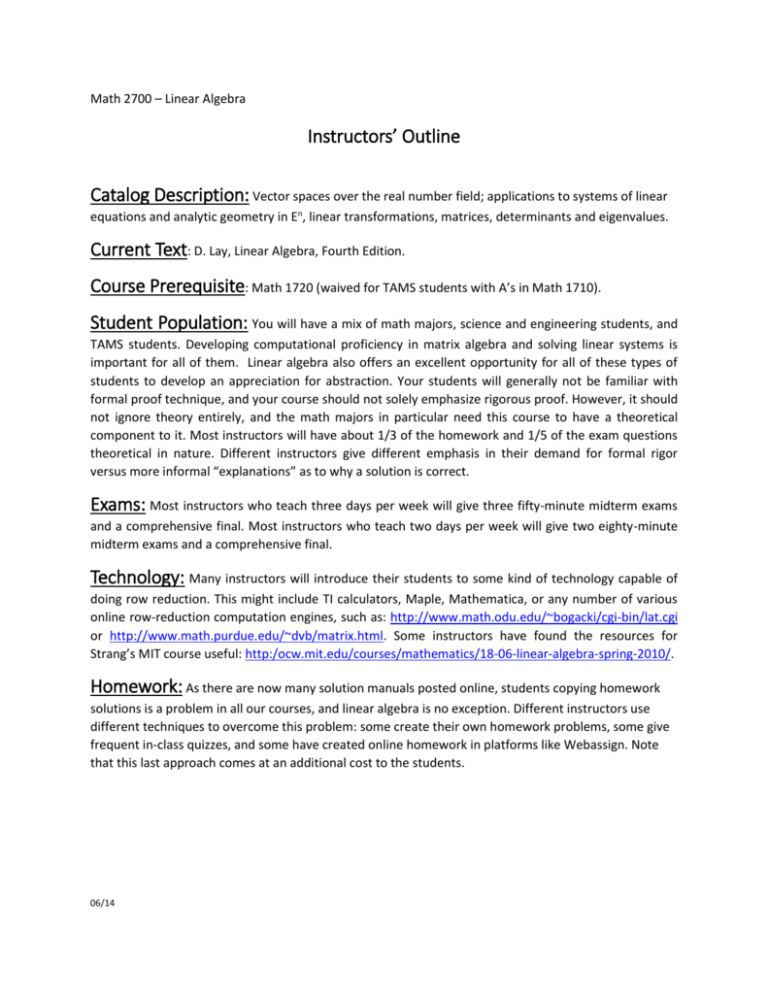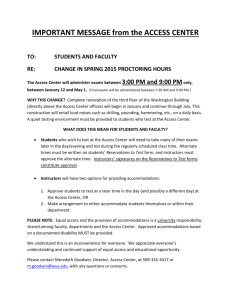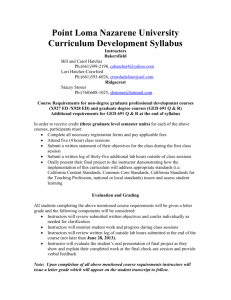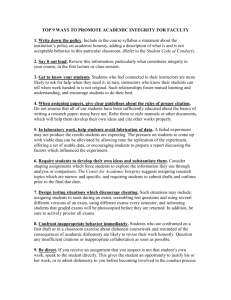2700 Course Outline for Instructors
advertisement

Math 2700 – Linear Algebra Instructors’ Outline Catalog Description: Vector spaces over the real number field; applications to systems of linear equations and analytic geometry in En, linear transformations, matrices, determinants and eigenvalues. Current Text: D. Lay, Linear Algebra, Fourth Edition. Course Prerequisite: Math 1720 (waived for TAMS students with A’s in Math 1710). Student Population: You will have a mix of math majors, science and engineering students, and TAMS students. Developing computational proficiency in matrix algebra and solving linear systems is important for all of them. Linear algebra also offers an excellent opportunity for all of these types of students to develop an appreciation for abstraction. Your students will generally not be familiar with formal proof technique, and your course should not solely emphasize rigorous proof. However, it should not ignore theory entirely, and the math majors in particular need this course to have a theoretical component to it. Most instructors will have about 1/3 of the homework and 1/5 of the exam questions theoretical in nature. Different instructors give different emphasis in their demand for formal rigor versus more informal “explanations” as to why a solution is correct. Exams: Most instructors who teach three days per week will give three fifty-minute midterm exams and a comprehensive final. Most instructors who teach two days per week will give two eighty-minute midterm exams and a comprehensive final. Technology: Many instructors will introduce their students to some kind of technology capable of doing row reduction. This might include TI calculators, Maple, Mathematica, or any number of various online row-reduction computation engines, such as: http://www.math.odu.edu/~bogacki/cgi-bin/lat.cgi or http://www.math.purdue.edu/~dvb/matrix.html. Some instructors have found the resources for Strang’s MIT course useful: http:/ocw.mit.edu/courses/mathematics/18-06-linear-algebra-spring-2010/. Homework: As there are now many solution manuals posted online, students copying homework solutions is a problem in all our courses, and linear algebra is no exception. Different instructors use different techniques to overcome this problem: some create their own homework problems, some give frequent in-class quizzes, and some have created online homework in platforms like Webassign. Note that this last approach comes at an additional cost to the students. 06/14 Sections of Lay’s book to be sure to cover Chapter 1 Essential sections: 1.1, 1.2, 1.3, 1.4, 1.7, 1.8, and 1.9. It is also highly recommended that at least some of the applications discussed in sections 1.5 and 1.10 be introduced. Chapter 2 Essential sections: 2.1, 2.2.2.3, 2.8, 2.9 (Note that the material in sections 2.8 and 2.9 is for the most part again repeated in Chapter 4, so this material can either be covered here or later in Chapter 4). Some introduction to 2.5 will be of value to engineers, particularly computer scientists. Some discussion of applications in 2.6 or 2.7 is also desirable. Chapter 3 Essential sections: 3.1, 3.2. Not all instructors cover section 3.3 since this material is also covered in Math 2730. Chapter 4 Essential sections: 4.1—4.7. Some treatment of 4.8 and/or 4.9 is also nice. Chapter 5 Essential sections: 5.1—5.5. Some practical interpretation of eigenvalues should also be given, for example by discussing dynamical systems or differential equations as in 5.6 or 5.7. Chapter 6 Essential sections: 6.1—6.4. It is nice to also add a light treatment of some of the remaining sections of the book. Working through the exercises in sections 6.5 and 7.4, for instance, helps review a number of fundamental concepts and can be good review for the final exam. The Lay book has a theme to most of its theoretically oriented questions: reduce the question to an analysis of the pivots. This gives the students a place to start in their approach to the theoretical questions. 06/14 Sample Weekly Schedule Note that there is considerable overlap in the material in Chapter 4 and concepts presented earlier in the later parts of Chapter 1 or in sections 2.8 or 2.9. Some instructors will go more slowly through Chapter 1, cover sections 2.8 and 2.9 in detail, and then more quickly through Chapter 4. Others will go through Chapter 1 rather quickly, skip 2.8 and 2.9, and then proceed more slowly and thoroughly through Chapter 4. The schedule below takes the former approach and should leave plenty of room for 150—160 minutes for midterm exams, although not enough slack for a full review period the days before the exams. Week 1: §1.1—1.3 Week 2: §1.4—1.6 Week 3: §1.6—1.7 Week 4: §1.8—1.9 Week 5: §2.1—2.3 Week 6: §2.5, 2.6, and 2.8 Week 7: §2.8-2.9 Week 8: §3.1—3.2 Week 9: §3.3, 4.1—4.3 (very light coverage of 3.3 and 4.1) Week 10: §4.4—4.6 Week 11: §4.7, 5.1, and 5.2 Week 12: §5.3—5.5 Week 13: §5.7, 6.1, and 6.2 Week 14: §6.3—6.5 Week 15: §7.1, 7.4, and review (or catch-up or slack for snow days). 06/14


